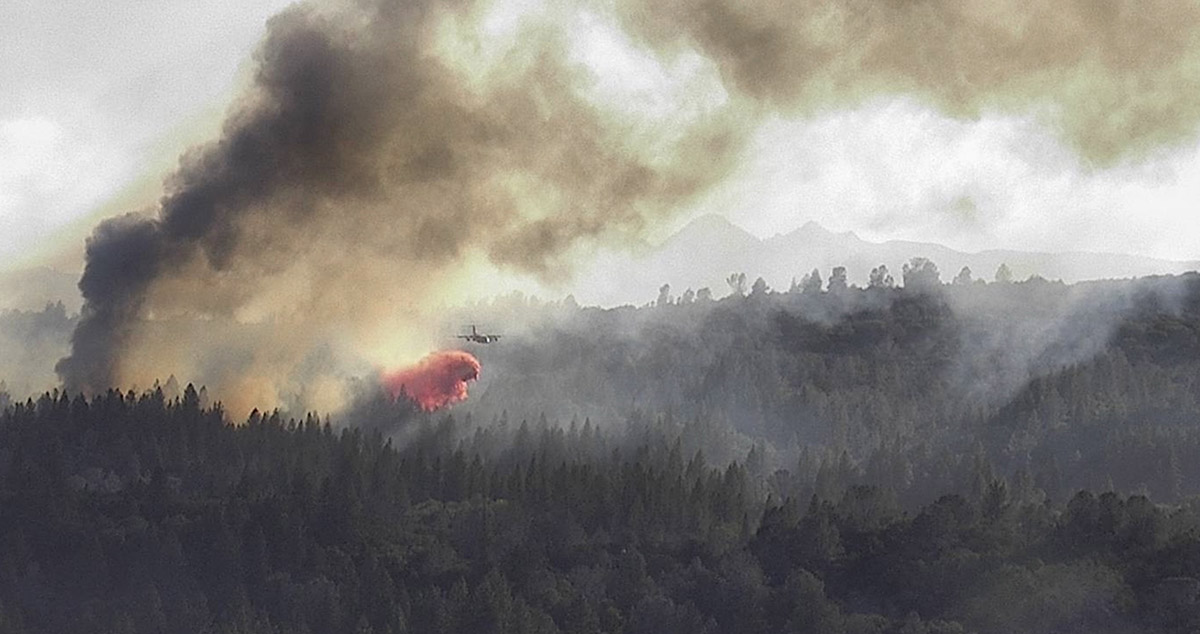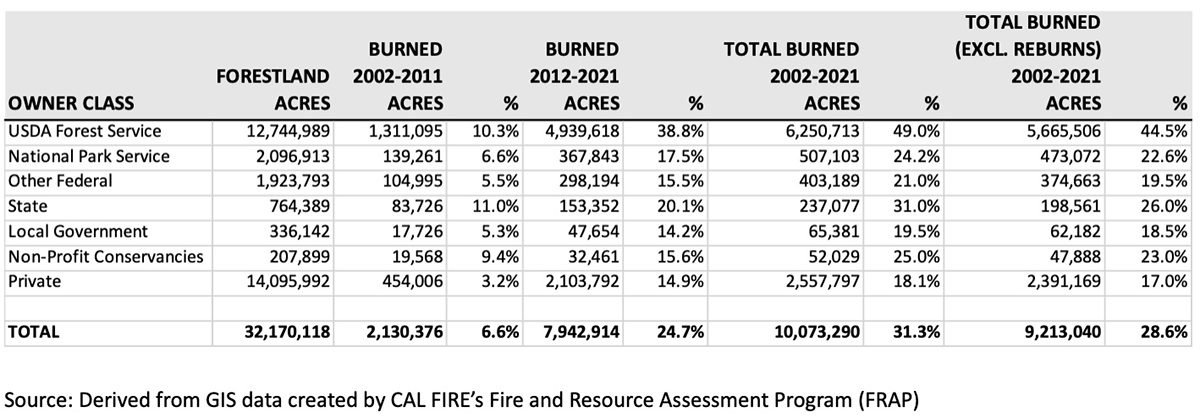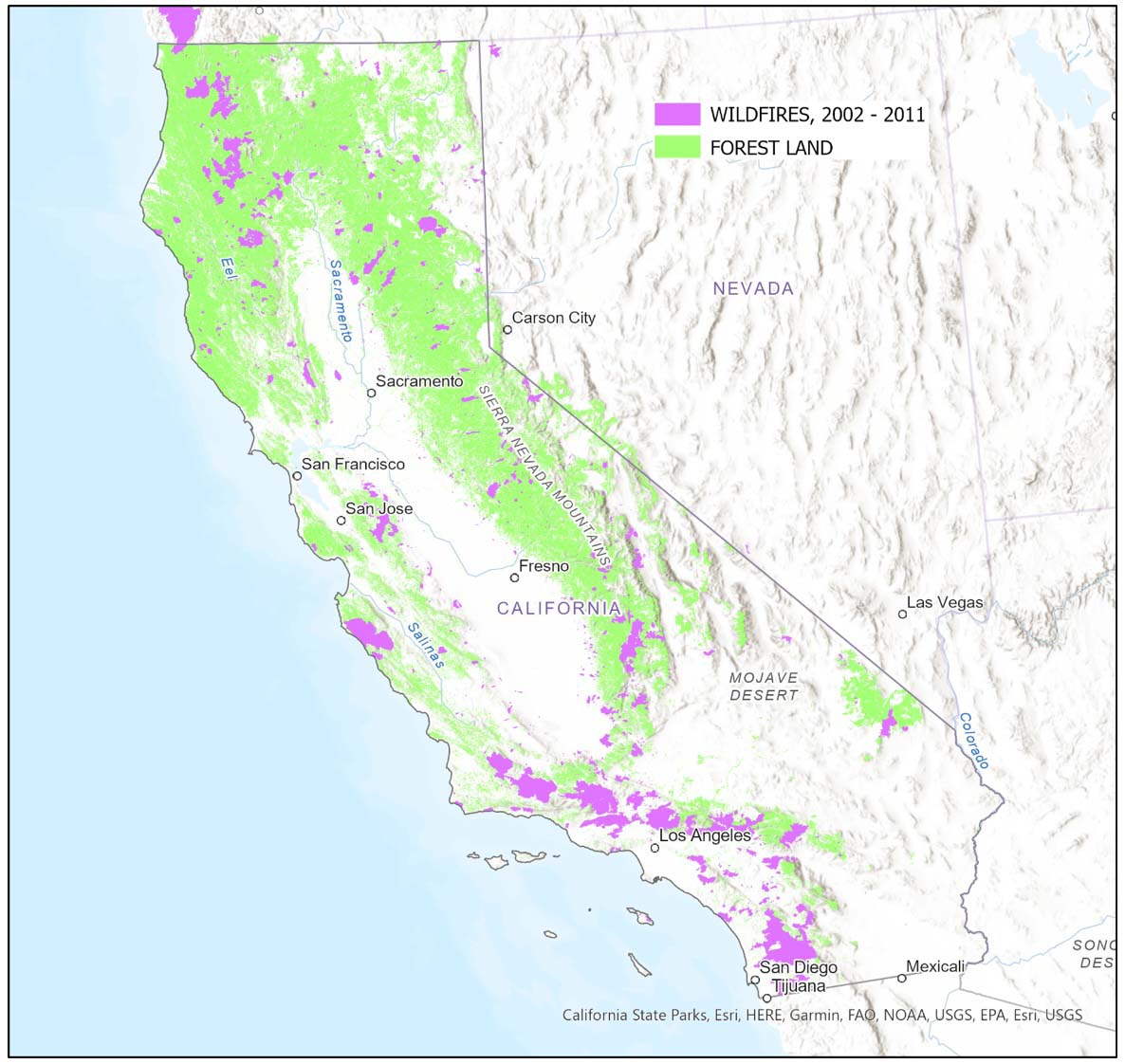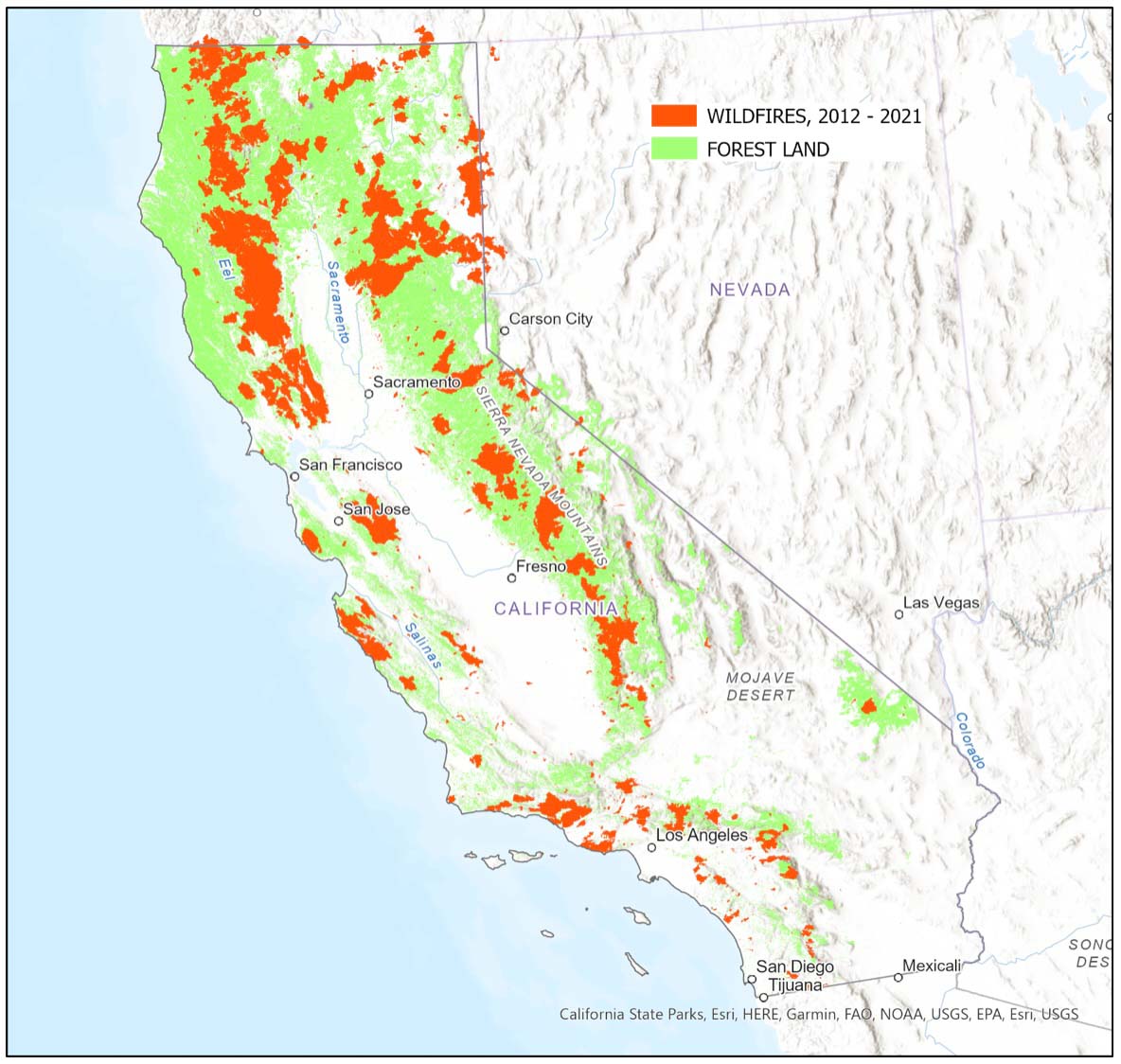
By Jim Schmidt
Of the 32.1 million acres of forestland in California, approximately 2.1 million acres (6.6%) burned in wildfires in the 2002-2011 time period. In the following decade (2012-2021), that figure more than tripled to 7.9 million acres (24.7%).
National Forests in California were particularly hard hit. 10.1% of 12.7 million acres of forestland managed by the USDA Forest Service in California burned in 2002 – 2011 time period. In the 2012 – 2021 decade that figure increased to 38.8%. Excluding areas that re-burned in the last 10 years, 44.5% of the forestland in California National Forests has burned in the last 20 years. In contrast, only 22.6% of National Park forestland in the state has burned in the same time period. About 14 million acres of forestland in California are in private hands. 17.0 % of private forestland has burned since 2001.

The following maps display the forestland areas and the areas that have burned in California in the last two decades. Fires were concentrated in Southern California in the 2002-2011 time period and in Northern California in the last 10 years.


The article was edited September 7 with revised figures to account for areas that reburned, which account for about 5% of the forestland burned on National Forests in the last 20 years.
Jim Schmidt retired from the Stanislaus National Forest where he worked as a GIS specialist.

Historically, before European settlement, up to 3% of Californias area would burn either by natural ignition or at the hands of the indigenous population, PER YEAR. That means that 25% over 10 years is still 5% behind the “natural” cycle.
https://www.sierraforestlegacy.org/Resources/Conservation/FireForestEcology/FireScienceResearch/FireHistory/FireHistory-Stephens07.pdf
Fear mongering.
My old friends in Napa, CA were sitting in 111 degrees last night. PG&E was doing blackouts. All of the West is the victim of a huge experiment in Climate Change. This is not being conducted by scientists. It is being done by climate deniers all over Earth. Since most humans are not doing a single thing to change, it will only get worse. These studies about burns in National Forest lands verses National Park lands tell us a lot. Just look at the Sequoias burned in National Monuments administered by the Forest Service compared to the Sequoias protected under National Park administration. Does the USFS need anymore of a wake up call? All National Parks and Monuments need to be administered by the NPS, not by those who traditionally focus on board feet.
All National Parks and Monuments are administered by the National Park Service under the Department of the Interior, not the USFS whichis under the Department of Agriculture.
Sorry, but you are wrong. Many areas that once were administrated by the USFS and later became National Monuments are still administered by the USFS. Giant Sequoia National Monument, that lost so many ancient trees last year, is administrated by the USFS. A quick look up on Google will show you.
When I look at the 2012 to 2021 map, my eyes are drawn to the Tahoe NF. There hasn’t been a large fire in the Yuba watershed (yet). That seems like a place to focus a lot of resources rapidly to get fuels treatments done. No time to wait.
We need fuels treatments ASAP, not logging. The forest service is good at getting the logs off of a project, but not the fuels. There are hundreds of thousands of acres NEPA ready for fuels treatments sitting there with no staff or funding to do the hard work, so don’t blame enviros, species or the regulations. The Caldor Fire is proof that line of reasoning isn’t worth much.
If fuel treatments generate some commercial value, that’s great, but trees greater than 20 inches diameter are not a driver of wildfire. Live and dead fuels build much faster than boards in every western frequent fire adapted forest system of all structural complexities. Fisher and spotted owls would be just fine if we reintroduced Rx fire in their habitat, even without any pre-treatment. The national parks have great owl and fisher habitat that has burned under appropriate fire weather conditions without pre-treatment.
A lot of CA has a significant high-severity-fire-loving shrub component, an issue logging has no effect on. There are only three ways to deal with the shrubs, frequent fire (chaparral type shrubs are not adapted to frequent fire), herbicide, or mastication. Frequent fire also deals with dead fuel build up, so it’s a twofer and a more ecologically friendly choice than herbicide. Mastication is expensive, so it’s not a good choice for perpetual maintenance. If you don’t deal with the chaparral shrubs, it wont matter how many trees one logs of any diameter, the shrubs will win and convert the place to chaparral. If you cut the forest to low density open conditions, without returning frequent fire, you’ll definitely be dealing with lots of sun loving waxy leafed shrubs that want to burn hot every 20-60 years, which is what we are doing. Anyone who says “if only we had logged more 20 years ago” doesn’t understand this part of the system. We be in the same place we are now. Not to mention, a great number of those red blobs on the map are in areas with no commercial timber value, where there cannot be a logging component.
Is it a reasonable to takeaway from these statistics that a natural fire regime is re-creating itself? That is, in a climate changing world forests are burning regardless of our human efforts to control, manage or constrain it?
This is an ominous trend. Sadly, it was predicted by many (including me) that without more intensive and extensive active management of owl, fisher and other dense tree canopy habitat associated species, this would greatly contribute to what we are now seeing. I’m not saying I told you so, I’m just deeply disturbed. What is missing in this report is fire severity and how much type conversion from Forest to shrub or grass there has been. When many fires are so large and intense, more of this happens and with hotter, drier conditions, trees just don’t come back or survive as well. I know some areas, particularly on the Klamath and eastern Sequoia forests have burned repeatedly with mixed severity. Did they fare better? I’m glad I’m retired and spend more of my time working with private, small landowners, Firewise Communities and prescribed burn associations get more done. They are more nimble and don’t have as many “stakeholders” fighting over their action choices. We need more microgrants! I also write grants to help agencies get more contingency funding for prescribed burns. I never give up—it’s still one of the most valuable tools we have. Small chunks or not.
It pretty much makes Rx fire a moot point there. By the time you get NEPA, write a burn plan and wait around for an ignitions window…a wildfire will burn it first. Happening like that all over the west, the time for big landscape scale Rx burns (the only ones actually worth anything) passed us by in the 70’s and 80’s.
Am I reading that graph correctly?
USFS acres burned almost quadrupled in 10 short years to ~40%.
If the rate of increase were halved ‘only’ 80 of the USFS forests in CA would burn over 10 years?
If that rate of increase were sustained over the next 10 years every one of those acres would burn, and half of it would burn again?
If so, prescribed fire is is indeed moot.
Nothing has been done with over grown Forest because environmentalists. They would rather see all the engendered burn up.
Clarification please.
Is this forest land under National Forest management or all National Forest land? The National Forests contain grasslands, shrublands, non-forest alpine, and other lands not meeting the definition of forested.
This analysis just includes land classified as either hardwood or conifer type in the statewide vegetation maps produced by CAL FIRE’s Fire and Resource Assessment Program (FRAP).
Do a study that includes all relevant factors, such as slash left behind by logging. God is in the details.